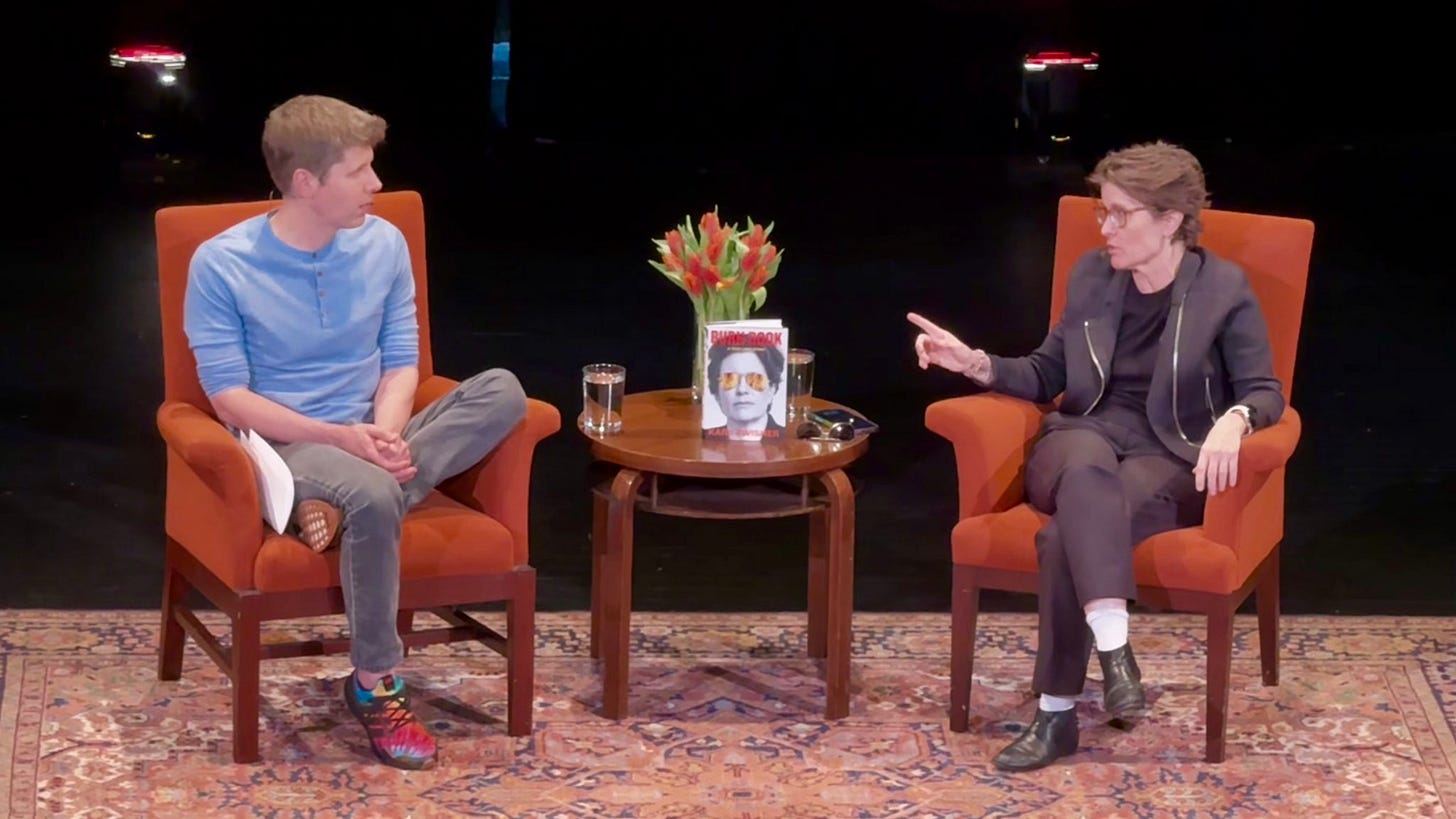Kara Swisher's story about Sam Altman is falling apart
The supposed hard-hitting journalist was peddling Altman’s narrative during his ouster from OpenAI

When Sam Altman was ousted as CEO of OpenAI on November 17, 2023, Kara Swisher started tweeting up a storm of “scoopage,” as she referred to her calls with high-ranking tech figures. Over the days Altman was on the outside, Swisher helped to craft a narrative that a board stacked with his internal rivals had pulled off a coup without a legitimate reason. The face of the AI boom had been betrayed and deserved to retake his position at the helm.
Swisher has been open about the fact she personally likes Altman. In her memoir Burn Book, she wrote, “I have come to know and like the young entrepreneur since I met him in 2005.” He also joined Swisher for an event in San Francisco to promote the book earlier this year. During his ouster, Swisher’s narrative was the story Altman wanted told. It cast him as the victim and helped to set the foundation for his triumphant return — one that would increase his power over the company and serve key investors like Microsoft.
In Swisher’s framing, which she repeats in her book, OpenAI was riven by divisions between AI optimists like Altman and doomers like cofounder and chief scientist Ilya Sutskever who believed artificial general intelligence (AGI) was on the horizon, presented a threat to humanity, and that the company wasn’t doing enough to mitigate that threat. The doomer camp took its opportunity to oust Altman, but misjudged its power and Altman was restored days later.
Kara Swisher’s Reality Distortion Field
In her commentary, Swisher often focused on a statement that Altman hadn’t been “candid” in his communications with the board, using it to suggest there was no real reason for Altman’s removal beyond factionalism, while claims he was “manipulative and headstrong” were dismissed as “sound[ing] like a typical [Silicon Valley] CEO to me.” She even went on CNN to call OpenAI’s board “incompetent” and to advocate for their resignation to open the way for Altman’s reinstatement.
Internal division was surely one factor in the board’s decision, but Swisher’s narrative and outright advocacy for Altman skillfully downplayed other factors whose details started to become clearer after his swift return as CEO. Those allegations focused more on Altman’s conduct and treatment of employees — things Swisher has a long history of ignoring as part of her “prick-to-productivity ratio.” Altman was another “prick” she cared more about being close to than seeing exposed.
Why Altman was really ousted
The day after Altman was restored as CEO, the Washington Post published a report into the side of his history that people like Swisher had little time for. Sources told the outlet the board was concerned that Altman was trying to remove checks on his power at OpenAI and had “a pattern of consistent and subtle manipulation that sows division between individuals.” A couple weeks later, journalist Nitasha Tiku built on that earlier reporting with more details suggesting Altman had been “psychologically abusive” and had allegedly been “pitting employees against each other in unhealthy ways.” Those actions had been central considerations for the board when they decided to remove him.
In 2019, Altman had also been removed as head of Y Combinator for putting “his own interests ahead of the organization,” according to the Post. At the time, he was making personal investments in companies he was selecting for inclusion in the accelerator’s fund. Even going back to his first startup Loopt, the management team had reportedly asked the board to remove him as CEO twice for “deceptive and chaotic behavior,” according to former OpenAI board member Helen Toner. Those details are often left out of the glowing profiles Altman receives today, not unlike how figures like Musk had their histories effectively rewritten once they became successful.
Elon Musk wants to relive his start-up days. He’s repeating the same mistakes.
During the ouster saga, OpenAI employees released a letter saying they’d resign en masse if Altman wasn’t restored as CEO. But the Washington Post found employees reported facing peer pressure to add their names and had a financial incentive to bring him back. If he wasn’t, an investment deal that would allow them to cash out would be put in jeopardy.
More recently, Vox revealed that employees were forced to sign strict non-disclosure and non-disparagement agreements once they left he company, or else they could lose their vested equity. Altman claimed he didn’t know about those clauses, but his response doesn’t line up with documents Vox obtained suggesting he would have been very aware and that company lawyers were aggressive in getting ex-employees to sign away their ability to speak about or criticize the company.
A recent interview Toner gave to the TED AI Show casts further doubt on Swisher’s version of events. Toner elaborated on the reasons Altman was removed from the company, explaining that two executives had spoken to the board about negative experiences with Altman that included lying, manipulation, and creating a toxic atmosphere at the company. Altman also didn’t disclose his ownership of the OpenAI Startup Fund and lied about the company’s safety processes. The board felt it “just couldn’t believe things that Sam was telling us,” explained Toner. She was also personally targeted by Alman when she published a research paper he didn’t like.
Ultimately, Toner explained the quick and stealthy removal of Altman as being necessary because if he knew in advance he’d “pull out all the stops, do everything in his power to undermine the board.” Those are clearly well-founded concerns, given that’s exactly what Altman did after he was ousted. He muddied the waters and ensured his narrative of events was the one that dominated the discussion about the company. Swisher served as a central conduit in that campaign.
Altman is cementing his power
After returning to OpenAI, Altman has cemented his power over the company. He brought in a new board that will be far less likely to challenge to his leadership. Earlier this month, Sutskever left the company, as did safety lead and company executive Jan Leike. OpenAI also dissolved the Superalignment team that Leike headed up. On Twitter, Leike explained that his disagreements with OpenAI leadership had been growing “for quite some time” and he was concerned “safety culture and processes have taken a backseat to shiny products.” Vox reported that five more of the company’s safety-conscious employees had left since Altman’s return as CEO as they lost trust in his leadership.
Scarlett Johansson can’t escape tech exploitation
To replace that team, OpenAI created a safety and security committee earlier this week stacked with company executives, including Altman himself. Meanwhile, the prospect of OpenAI throwing off the shackles of its non-profit status continues to be discussed and the company has reported branched out from its Microsoft dependency to sign a deal with Apple that will give it a greater sense of independence. Even in the face of the blowback from the non-disclosure scandal and the potential legal action from the drama over the use of a voice sounding very similar to Scarlett Johansson’s in GPT-4o, Altman’s power is only growing.
While Swisher might make the occasional jabs at the “man-boys” of Silicon Valley, as she refers to them in her book, she’s desperate to be in their circles and part of the power game. She’s chosen a few CEOs to more regularly criticize now that they don’t give her the access she craves, but there are many more whose narratives she will happily help turn into the official record whenever it will help them. Altman is in that group, and six months after his removal and return as CEO of OpenAI, it’s become very apparent that Swisher was echoing the Altman line and defending his interests. As she says in her book, she’s happy to give “flawed people … a little break,” as long as they have the power to justify it.




